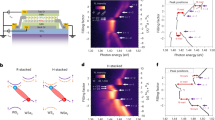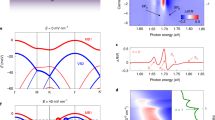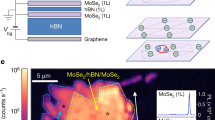Abstract
Moiré superlattices can be used to engineer strongly correlated electronic states in two-dimensional van der Waals heterostructures, as recently demonstrated in the correlated insulating and superconducting states observed in magic-angle twisted-bilayer graphene and ABC trilayer graphene/boron nitride moiré superlattices1,2,3,4. Transition metal dichalcogenide moiré heterostructures provide another model system for the study of correlated quantum phenomena5 because of their strong light–matter interactions and large spin–orbit coupling. However, experimental observation of correlated insulating states in this system is challenging with traditional transport techniques. Here we report the optical detection of strongly correlated phases in semiconducting WSe2/WS2 moiré superlattices. We use a sensitive optical detection technique and reveal a Mott insulator state at one hole per superlattice site and surprising insulating phases at 1/3 and 2/3 filling of the superlattice, which we assign to generalized Wigner crystallization on the underlying lattice6,7,8,9,10,11. Furthermore, the spin–valley optical selection rules12,13,14 of transition metal dichalcogenide heterostructures allow us to optically create and investigate low-energy excited spin states in the Mott insulator. We measure a very long spin relaxation lifetime of many microseconds in the Mott insulating state, orders of magnitude longer than that of charge excitations. Our studies highlight the value of using moiré superlattices beyond graphene to explore correlated physics.
This is a preview of subscription content, access via your institution
Access options
Access Nature and 54 other Nature Portfolio journals
Get Nature+, our best-value online-access subscription
$29.99 / 30 days
cancel any time
Subscribe to this journal
Receive 51 print issues and online access
$199.00 per year
only $3.90 per issue
Buy this article
- Purchase on Springer Link
- Instant access to full article PDF
Prices may be subject to local taxes which are calculated during checkout




Similar content being viewed by others
Data availability
The data that support the findings of this study are available from the corresponding author upon reasonable request.
References
Cao, Y. et al. Correlated insulator behaviour at half-filling in magic-angle graphene superlattices. Nature 556, 80–84 (2018).
Cao, Y. et al. Unconventional superconductivity in magic-angle graphene superlattices. Nature 556, 43–50 (2018).
Chen, G. et al. Evidence of a gate-tunable Mott insulator in a trilayer graphene moiré superlattice. Nat. Phys. 15, 237–241 (2019).
Chen, G. et al. Signatures of tunable superconductivity in a trilayer graphene moiré superlattice. Nature 572, 215–219 (2019).
Wu, F., Lovorn, T., Tutuc, E. & MacDonald, A. H. Hubbard model physics in transition metal dichalcogenide moire bands. Phys. Rev. Lett. 121, 026402 (2018).
Wigner, E. On the interaction of electrons in metals. Phys. Rev. 46, 1002–1011 (1934).
Hubbard, J. Generalized Wigner lattices in one dimension and some applications to tetracyanoquinodimethane (TCNQ) salts. Phys. Rev. B 17, 494–505 (1978).
Wu, C., Bergman, D., Balents, L. & Das Sarma, S. Flat bands and Wigner crystallization in the honeycomb optical lattice. Phys. Rev. Lett. 99, 070401 (2007).
Hiraki, K. & Kanoda, K. Wigner crystal type of charge ordering in an organic conductor with a quarter-filled band: (D1-DCNQI)2Ag. Phys. Rev. Lett. 80, 4737–4740 (1998).
Padhi, B., Setty, C. & Phillips, P. W. Doped twisted bilayer graphene near magic angles: proximity to Wigner crystallization, not Mott insulation. Nano Lett. 18, 6175–6180 (2018).
Padhi, B. & Phillips, P. W. Pressure-induced metal-insulator transition in twisted bilayer graphene. Phys. Rev. B 99, 205141 (2019).
Mak, K. F., He, K., Shan, J. & Heinz, T. F. Control of valley polarization in monolayer MoS2 by optical helicity. Nat. Nanotechnol. 7, 494–498 (2012).
Xiao, D., Liu, G.-B., Feng, W., Xu, X. & Yao, W. Coupled spin and valley physics in monolayers of MoS2 and other group-VI dichalcogenides. Phys. Rev. Lett. 108, 196802 (2012).
Cao, T. et al. Valley-selective circular dichroism of monolayer molybdenum disulphide. Nat. Commun. 3, 887 (2012).
Chen, G. et al. Tunable correlated Chern insulator and ferromagnetism in trilayer graphene/boron nitride moire superlattice. Preprint at https://arxiv.org/abs/1905.06535 (2019).
Kadantsev, E. S. & Hawrylak, P. Electronic structure of a single MoS2 monolayer. Solid State Commun. 152, 909–913 (2012).
Fallahazad, B. et al. Shubnikov–de Haas oscillations of high-mobility holes in monolayer and bilayer WSe2 Landau level degeneracy, effective mass, and negative compressibility. Phys. Rev. Lett. 116, 086601 (2016).
Roch, J. G. et al. Spin-polarized electrons in monolayer MoS2. Nat. Nanotechnol. 14, 432–436 (2019).
Back, P. et al. Giant paramagnetism-induced valley polarization of electrons in charge-tunable monolayer MoSe2. Phys. Rev. Lett. 118, 237404 (2017).
Splendiani, A. et al. Emerging photoluminescence in monolayer MoS2. Nano Lett. 10, 1271–1275 (2010).
Mak, K. F., Lee, C., Hone, J., Shan, J. & Heinz, T. F. Atomically thin MoS2: a new direct-gap semiconductor. Phys. Rev. Lett. 105, 136805 (2010).
Mott, N. F. The basis of the electron theory of metals, with special reference to the transition metals. Proc. Phys. Soc. A 62, 416–422 (1949).
Imada, M., Fujimori, A. & Tokura, Y. Metal-insulator transitions. Rev. Mod. Phys. 70, 1039–1263 (1998).
Allain, A., Kang, J., Banerjee, K. & Kis, A. Electrical contacts to two-dimensional semiconductors. Nat. Mater. 14, 1195–1205 (2015).
Jin, C. et al. Observation of moiré excitons in WSe2/WS2 heterostructure superlattices. Nature 567, 76–80 (2019); correction 569, E7 (2019).
Zhang, Y., Yuan, N. F. Q. & Fu, L. Moiré quantum chemistry: charge transfer in transition metal dichalcogenide superlattices. Preprint at https://arxiv.org/abs/1910.14061 (2019).
Lenarčič, Z. & Prelovšek, P. Ultrafast charge recombination in a photoexcited Mott–Hubbard insulator. Phys. Rev. Lett. 111, 016401 (2013).
Okamoto, H. et al. Photoinduced transition from Mott insulator to metal in the undoped cuprates. Phys. Rev. B 83, 125102 (2011).
Giannetti, C. et al. Ultrafast optical spectroscopy of strongly correlated materials and high-temperature superconductors: a non-equilibrium approach. Adv. Phys. 65, 58–238 (2016).
Kim, J. et al. Observation of ultralong valley lifetime in WSe2/MoS2 heterostructures. Sci. Adv. 3, e1700518 (2017).
Jin, C. et al. Imaging of pure spin–valley diffusion current in WS2/WSe2 heterostructures. Science 360, 893–896 (2018).
Law, K. T. & Lee, P. A. 1T-TaS2 as a quantum spin liquid. Proc. Natl Acad. Sci. USA 114, 6996–7000 (2017).
Grover, T., Trivedi, N., Senthil, T. & Lee, P. A. Weak Mott insulators on the triangular lattice: Possibility of a gapless nematic quantum spin liquid. Phys. Rev. B 81, 245121 (2010).
Wang, L. et al. One-dimensional electrical contact to a two-dimensional material. Science 342, 614–617 (2013).
Kumar, N. et al. Second harmonic microscopy of monolayer MoS2. Phys. Rev. B 87, 161403 (2013).
Li, Y. et al. Probing symmetry properties of few-layer MoS2 and h-BN by optical second-harmonic generation. Nano Lett. 13, 3329–3333 (2013).
Acknowledgements
We thank S. Li for discussions, S. Wang for help with device fabrication, and C. Stansbury and C. Wang for assistance with figure design. This work was supported primarily by the US Department of Energy, Office of Science, Office of Basic Energy Sciences, Materials Sciences and Engineering Division under contract number DE-AC02-05-CH11231 (van der Waals heterostructures programme, KCWF16). The device fabrication was also supported by the US Army Research Office under MURI award W911NF-17-1-0312. E.C.R. acknowledges support from the Department of Defense through the National Defense Science & Engineering Graduate Fellowship (NDSEG) Program. C.J. acknowledges support from a Kavli Postdoctoral Fellowship. S.T. acknowledges support from NSF DMR-1552220 and 1838443.
Author information
Authors and Affiliations
Contributions
F.W. conceived the research. E.C.R., D.W. and C.J. carried out optical measurements. D.W., E.C.R., C.J. and F.W. performed data analysis. E.C.R., D.W., B.G., X.W., M.I.B.U., S.Z., W.Z., Z.Z., J.D.C., M.C. and A.Z. contributed to the fabrication of van der Waals heterostructures. K.Y., M.B. and S.T. grew WSe2 and WS2 crystals. K.W. and T.T. grew hBN crystals. All authors discussed the results and wrote the manuscript.
Corresponding author
Ethics declarations
Competing interests
The authors declare no competing interests.
Additional information
Peer review information Nature thanks Alexander Tartakovskii and the other, anonymous, reviewer(s) for their contribution to the peer review of this work.
Publisher’s note Springer Nature remains neutral with regard to jurisdictional claims in published maps and institutional affiliations.
Extended data figures and tables
Extended Data Fig. 1 WSe2 A exciton gate behaviour.
a, Reflection contrast spectra for the lowest-energy WSe2 A exciton resonance in region 2 of device D1 when the local top-gate voltage Vtop is tuned from 0.5 V to –3.5 V. Region 2 is not affected when the hole concentration is tuned in region 1 by Vtop. b, Reflection contrast spectra for the WSe2 A exciton in region 2 when the global back gate is tuned from −0.95 V to −1.05 V. The inset shows a zoomed-in view of the exciton peak. The spectral change is monotonic and approximately linear with carrier concentration.
Extended Data Fig. 2
ODRC signal measured at very low frequencies for a range of modulation voltages. Vmod, modulation voltage.
Extended Data Fig. 3 Calibration of hBN dielectric constant.
a, MoSe2 A exciton peak intensity measured while tuning the voltages of the top graphite gate and back Si gate. b, The extracted charge-neutral points (CNP, dots) for each Si back gate, corresponding to the top graphite gate voltages that bring the system to zero net charge. The black line is a linear fit to the data, from which the relative gate efficiency is determined.
Extended Data Fig. 4 Determination of WSe2 and WS2 flake alignment.
Polarization-dependent SHG signal on monolayer WSe2 (red circles) and WS2 (black circles) regions of device D1 and corresponding fittings (red and black curves, respectively).
Extended Data Fig. 5 ODRC signal for other aligned WSe2/WS2 heterostructures.
a, b, ODRC signal at low (grey) and high (black) frequency from charge-neutral to moderate hole doping in devices D2 (a) and D3 (b). The dashed lines are guides to the eye at hole concentrations of n = 0 (purple), n = n0/3 (orange), n = 2n0/3 (green) and n = n0 (blue).
Extended Data Fig. 6 ODRC signal for a large-twist-angle WSe2/WS2 heterostructure.
a, Normalized ΔOC for a large-twist-angle heterostructure (D4, blue) and an aligned heterostructure (D1, black). The misaligned heterostructure does not show any insulating features. b, The frequency dependence of the large-twist-angle heterostructure signal shows a characteristic RC circuit fall-off with increasing frequency.
Supplementary information
Supplementary Information
This file contains the Effective AC Circuit Model.
Rights and permissions
About this article
Cite this article
Regan, E.C., Wang, D., Jin, C. et al. Mott and generalized Wigner crystal states in WSe2/WS2 moiré superlattices. Nature 579, 359–363 (2020). https://doi.org/10.1038/s41586-020-2092-4
Received:
Accepted:
Published:
Issue Date:
DOI: https://doi.org/10.1038/s41586-020-2092-4
This article is cited by
-
Observation of spin polarons in a frustrated moiré Hubbard system
Nature Physics (2024)
-
Giant spin Hall effect in AB-stacked MoTe2/WSe2 bilayers
Nature Nanotechnology (2024)
-
Realization of the Haldane Chern insulator in a moiré lattice
Nature Physics (2024)
-
Competing itinerant and local spin interactions in kagome metal FeGe
Nature Communications (2024)
-
Excitonic Mott insulator in a Bose-Fermi-Hubbard system of moiré WS2/WSe2 heterobilayer
Nature Communications (2024)
Comments
By submitting a comment you agree to abide by our Terms and Community Guidelines. If you find something abusive or that does not comply with our terms or guidelines please flag it as inappropriate.



